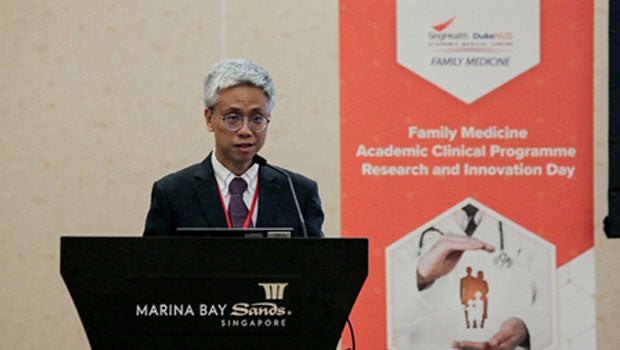
With variations in assessment methods and diagnostic criteria for sarcopenia, a degenerative condition that causes the loss of muscle mass and strength due to ageing, it has been tough to accurately diagnose this condition. Hopefully, this is set to change. Adjunct Associate Professor Tan Ngiap Chuan is currently overseeing a research project to develop a diagnostic kit for healthcare providers to confidently diagnose sarcopenia among the older people.
Singaporeans are now the longest-living people in the world, living an average of 83.2 years as of 2018*. This sounds like good news—only if you don’t succumb to age-related diseases, many of which will significantly reduce the quality of your life. Sarcopenia, which results in the loss of muscular mass and strength, is one such disease.
One passionate researcher of sarcopenia in Singapore is Adjunct Associate Professor Tan Ngiap Chuan, Director (Research) of SingHealth Polyclinics and Academic Vice-Chair (Research) of the SingHealth Duke-NUS Family Medicine Academic Clinical Programme.
Adj Assoc Prof Tan Ngiap Chuan presenting at the Family Medicine Academic Clinical Programme Research and Innovation Day in February this year.
Taking sarcopenia in its stride
Sarcopenia seems easy enough to understand. However, what complicates it are the problems it tends to cause.
Adj Assoc Prof Tan explains, “Older people with sarcopenia often have falls, which cause them to suffer from bone fractures (usually the hip) and render them immobile for a period of time. This tends to send them into a downward spiral of superimposed acute infections, mental decline, and an overall depreciation in the quality of their lives.”
Helping older people and caregivers recognise the symptoms of sarcopenia early is important, but this leads to another problem: sarcopenia is notoriously challenging to accurately diagnose.
“Unfortunately, sarcopenia is one of those diseases that varies across studies in terms of diagnostic criteria, assessment methods, and muscle mass in different populations, leading to huge variations in prevalence rates,” says Adj Assoc Prof Tan, “For example, the prevalence rate of sarcopenia in the Asian population alone stands between 7.1 and 59.8 per cent – that’s a huge range!”
Aiming for the Gold Standard in diagnosis
Adj Assoc Prof Tan is currently overseeing a project to develop a diagnostic kit that will standardise the diagnostic criteria and assessment methods in Singapore.
In this kit, three sets of criteria will be used to determine if an individual has sarcopenia: (1) Hand grip strength (less than 26kg for men and 18kg for women) using a dynamometer; (2) Gait speed (the measure of how quickly someone can walk) over a distance of 6 metres (less than 0.8 m/s) which can be measured along any straight walkway or corridor, and (3) Muscle mass (less than 7.0 kg/m2 for men or 5.7kg/ m2 for women) via a bio-electrical impedance analysis, where a weak electric current is sent through the body and the voltage is measured in order to calculate resistance of the body.
Adj Assoc Prof Tan is hopeful that these measurements will facilitate the diagnosis of sarcopenia, so that older people are aware of it and to take measures to delay its progression.
"Sometimes, giving them an actual measurement helps them to have a better grasp of what they are suffering from, so they understand their conditions better and in more tangible ways.", Adj Assoc Prof Tan says.
He continues, "Having these standardised measurements that indicate whether they have sarcopenia or not can make a big difference to the older people. In many cases, they would be more willing to take actual steps to improve their muscle strength by doing prescribed exercises or making sure they eat right—both of which have shown to be able to dampen the development of sarcopenia."
With so many aspects of this disease still uncertain, Adj Assoc Prof Tan remains very much undaunted by all the work there is still left to do. He enthuses, “New discoveries still excite me, especially the experience of that golden “Eureka” moment that Archimedes had when he jumped out of the proverbial bathtub!”
“I hope that with the developments in diagnosing and treating sarcopenia, I will still be able to jump out of that tub in my old age!”
*Singapore Department of Statistics, 2019













 Get it on Google Play
Get it on Google Play